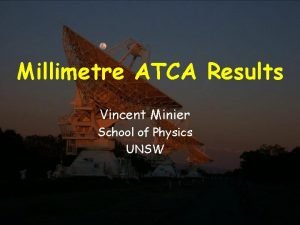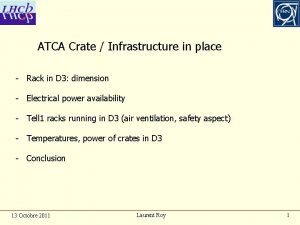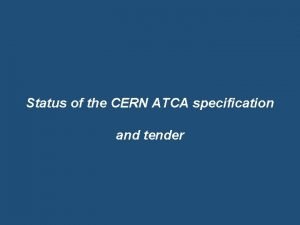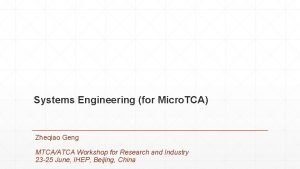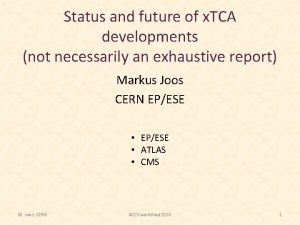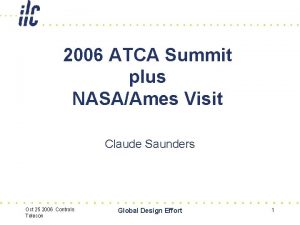HA PV Gateway in ATCA Ned Arnold Claude








- Slides: 8

HA PV Gateway in ATCA Ned Arnold Claude Saunders Argonne National Laboratory Office of Science U. S. Department of Energy A U. S. Department of Energy Office of Science Laboratory Operated by The University of Chicago

Process Variable Gateways @ APS • • • Each sector of experiments (35) has an isolated network (subnet) Only certain Process Variables must be accessible to/from the accelerator subnet. Other PV traffic must be blocked. A PV Gateway per beamline filters PV requests according to predefined rules (based on naming conventions). “Reverse Gateways” allow the accelerator subnet access to certain beamline PVs. To minimize hardware, multiple instances of the PV Gateway (2 -5) execute on a single workstation, requiring the workstation to have additional NICs. Currently, APS has 42 PV Gateways running on 10 workstations Effectively, this provides traffic isolation, filtering, security, and connection management at the application level of the control system. Such capability is essential for large machines. Beamline Subnet Beamline Subnet Accelerator Subnet Beamline Subnet 2 Pioneering Science and Technology Office of Science U. S. Department of Energy

EPICS PV Gateway Network Architecture – Now Cisco 6509 Switch Cisco 4507 Switch LOM 431 4 x 100 M lines Copper-fiber-copper 1234 Sun Gateway 431 4 VLAN, one per beamline LOM 432 …. 4 x 1 G LOM backbone LOM 437 Computer Room. 2 subnet Sun Gateway 432 8 x Sun Gateway hosts with Quad Gig. E NIC and 2 standard onboard NICs …. LOM 438 1234 Sun Gateway 438 . 2 subnet 3 Pioneering Science and Technology Office of Science U. S. Department of Energy

Modified Architecture – Option #1 Cisco 6509 Switch Cisco 4507 Switch LOM 431 4 x 100 M lines Copper-fiber-copper Computer Room 1234 4 VLAN, one per beamline LOM 432 …. 4 x 1 G LOM backbone LOM 437 LOM 438 Note: Simplest option. Does not modify traffic patterns or interfere with existing VLAN routing. Does not, however, get rid of 32 copperfiber-copper runs between LOMs and Computer room. We do gain advantage of managing all pv gateway nodes in one chassis. ATCA Chassis with 4 to 8 processor blades and 8 Quad NIC AMC Cards. . 2 subnet 1234 4 Pioneering Science and Technology Office of Science U. S. Department of Energy

Modified Architecture – Option #2 Cisco 6509 Switch Cisco 4507 Switch 10 G uplink or 4 x 1 G uplink LOM 431 1234 LOM 432 …. 4 x 1 G LOM backbone Note: More complex option. Makes several assumptions stated below. Gets rid of 32 copper-fiber-copper runs between LOMs and Computer room. We gain advantage of managing all pv gateway nodes in one chassis. ATCA Chassis with 8 processor blades with fabric Ethernet switching . 2 subnet LOM 437 LOM 438 1234 Pioneering Science and Technology Assumptions about current architecture: • Traffic on gateway between. 2 and LOM VLAN is small • LOM VLANs can be participated in using fabric switch on ATCA Chassis • Cisco does not use proprietary protocols to trunk VLANs • . 2 subnet is accessible somewhere near LOM backbone • Beamlines don’t object to having their VLANs trunked over backbone to ATCA chassis Office of Science U. S. Department of Energy 5

Why is this a good ILC R&D Project? • • • It is a real need with real requirements. It is entirely a “network traffic” challenge which aligns nicely with telecomcentric ATCA Can be done with commercial equipment … no custom hardware design We will learn *a lot* about - ATCA hardware and software tools - Routing of network traffic - Process monitoring, migration, and failover - Cost vs. performance of ATCA-based applications - Is it really “High Availability”? - How applications must be enhanced to take advantage of HA hardware/software The R&D effort will directly benefit APS and the APS Upgrade: - Understanding the benefits and costs of HA - May possibly provide a high performance, highly reliable solution for numerous gateways - Approach could be applied to other applications (loggers, RDBs, etc) 6 Pioneering Science and Technology Office of Science U. S. Department of Energy

Work Package • Purpose - • The ILC controls network will require controls traffic gateways in order to manage connections to the expected (large) number of control points. Controls gateways serve several purposes, but the most fundamental is to manage the issue of many control system clients trying to make connections to potentially every control point. Gateways are critical points of a control system, and very much a telecommunications-like application. We propose to explore the features of Advanced. TCA, both hardware and software, by taking an existing control system gateway, porting it to ATCA, and demonstrating the benefits gained from applying the technology from telecommunications. Goals - Demonstrate an existing process variable gateway, modified to provide telecomgrade management and availability, including failover to redundant hardware. Gain an understanding of the cost in time and materials to enhance a common controls function with high availability features from the telecom field. 7 Pioneering Science and Technology Office of Science U. S. Department of Energy

Work Package • Deliverables - • Effort - • Modified codebase for candidate gateway (EPICS Process Variable Gateway or other) using SAF-compliant AIS implementation. Reference architecture for deploying gateway software on ATCA shelf Operational demonstration of functions, including behavior when various faults are induced. Perhaps operational deployment at APS. Evaluation document of cost-benefit of effort 1 FTE for 1 year (or, more likely, 2 half FTE with complementary skills) Materials - 1 ATCA Chassis (with shelf management) with dual star base and fabric backplane 2 CPU blades with base and fabric ethernet 2 Switch blades with base and fabric switching External conventional server to as management and traffic simulation node 8 Pioneering Science and Technology Office of Science U. S. Department of Energy

